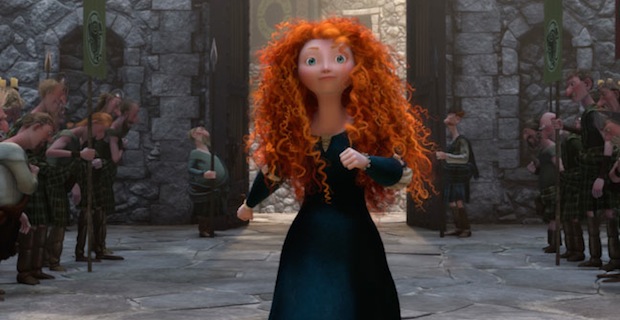
Even with 13 record-breaking animated pictures under its belt, Pixar’s success continues to astound. There is arguably no entertainment company with as much goodwill as the Disney-owned, California-based production studio. Since it unleashed Toy Story in 1995, Pixar has amassed one of the most loyal fan bases in movie history. The company’s consistent track record has allowed its name to become a stamp of quality on a product and even a powerful marketing tool. Supporters can point to the studio’s latest release Brave – which opened to a healthy $66.7 million this weekend – as more proof of the brand’s dominance in the animated films market. It’s easy to end the story there, but there are also some discomforting facts about the performance that suggest that Pixar’s flame may be burning a little less bright than we think. Here’s what Brave tells us about the state of the company in 2012:
Reasons for Pixar to be happy:
- The critics don’t matter
Brave opened to above average but tepid reviews, with critics expressing disappointment with the film’s formulaic script and lack of new ideas. A 74% rating on the Tomatometer may seem like a positive consensus but for a critical darling that routinely scores in the low to upper 90’s, it’s a surprisingly underwhelming result. The good news is that Brave’s performance demonstrates that a so-so critical evaluation does little to dissuade audiences from running to theaters.
The bad news is what the lack of enthusiasm among critics says about the direction of the company. Pixar made its name by pushing the boundaries of storytelling in animated movies. Characters were not reduced to cookie-cutter caricatures, adult emotions were injected into the mix, and complex themes were explored without excessive preaching. The development of a safer, more by-the-numbers family flick suggests the company may be falling into the Disney trap.
2. A healthy amount of the audience comes just for the brand
Brave marked Pixar’s first picture with a female as the lead character, an untested experiment for the studio. The attachment of multiple directors and screenwriters also increased fears that the film would lack a cohesive tone. Finally, the staying power of box office champ Madagascar 3, now in its third week of release, gave families another option at their local cinema.
Brave overcame all difficulties with ease and had no problem appealing to a diverse set of moviegoers. Although this weekend’s audience did lean female, males still comprised 43% of attendees. All of this shows one clear pattern. It doesn’t matter what the property is, it doesn’t matter whom it’s supposed to appeal to, and it doesn’t matter who the competition is. As long as the Pixar name is present, people will show up.
Reasons for Pixar to be worried:
1. Numbers can be misleading
Pixar executives were quick to praise the opening performance of Brave. Although the female aspect was mentioned, Disney’s Executive Vice President of Distribution Dave Hollis attributed the film’s success primarily to “universal love of this brand”. The film’s gross puts it at #5 on the list of the company’s best opening weekends. No reason to worry, right?
Well, the picture may not be as bright as it seems. Adjusted for ticket price inflation, Brave actually plummets to 9th place out of 13 in the rankings, a spot ahead of last year’s disappointing Cars 2. What the updated numbers tell us is that Brave’s healthy performance was due not to an actual increase in moviegoers but rather to people paying more per ticket. For those who say “money is money”, the difference is irrelevant. However, the discrepancy in results does indicate that the “Pixar as a brand” appeal may not be as strong as its leaders think. If the movie is so-so, the attendance will drop.
The film’s gross is also weakened slightly when you consider its budget. At $210 million, Brave was Pixar’s most expensive production to date. To make matters worse, great production costs also bring great marketing costs. Less people showing up for Pixar films as they grow costlier to create, promote, and distribute is not a good sign.
2. The Disney factor
From the moment Toy Story captured the hearts of audiences worldwide, Disney had its eyes set on acquiring the new kid on the block. Ever since the entertainment conglomerate purchased the studio in 2006 for $7.4 billion, it has been accused of excessively exploiting Pixar’s emotional connection with audiences for profit. Although it’s arguable that the quality of the films since the acquisition hasn’t taken a hit (2008’s WALL-E and 2009’s Up are two of Pixar’s most critically acclaimed efforts), the rapid release schedule may be taking a toll on the brand and the talented people behind the scenes.
A new Pixar flick now hits the theaters every summer. It’s interesting, considering that Toy Story’s follow-up, A Bug’s Life, arrived at theaters three years after the former’s debut. No matter the financial incentive, there’s no way to guarantee the foundation of a good Pixar flick. An excellent story, engaging characters and a smart message all take time to develop. The telltale signs of rushing to get Brave out – three directors and four screenwriters, a safe story with little risk, creative disagreements during production – are all here. At the end of the day, this is all mere speculation but one can’t help but wonder whether Disney is pushing Pixar to focus more on quantity than quality.
Written by: Boris Paskhaver
- EDITORIAL: “Resident Evil 5: What the Horror Flick’s Performance Tells Us About Industry Trends in 2012” - September 18, 2012
- EDITORIAL: “The Oogieloves: A Box Office Disaster for the Ages” - September 4, 2012
- EDITORIAL: “The Expendables 2: Why Stallone’s Ragtag Crew of Action Heroes Didn’t Deliver the Box Office Goods in Their Second Outing” - August 22, 2012
